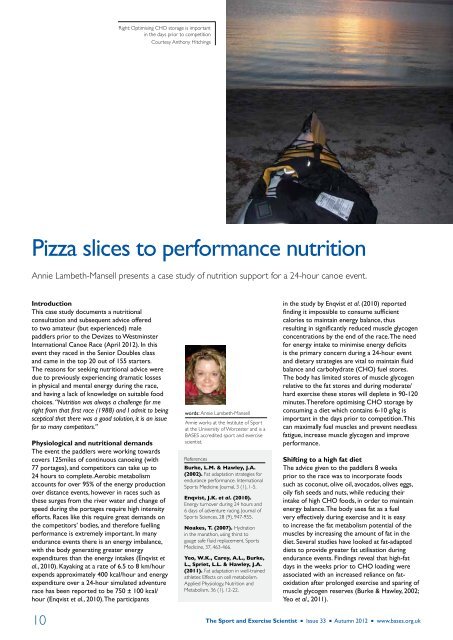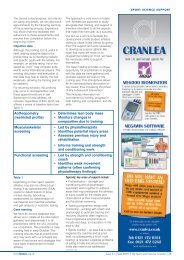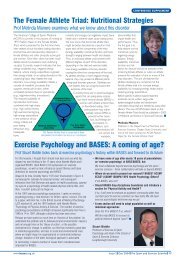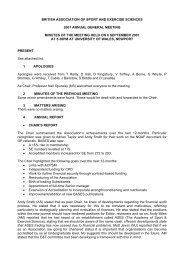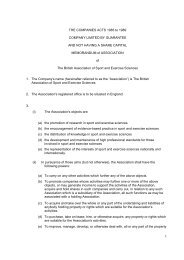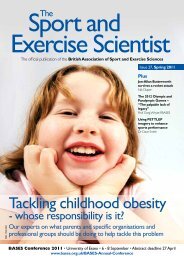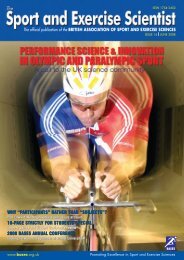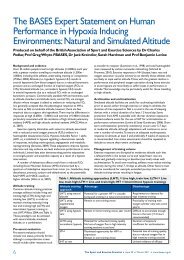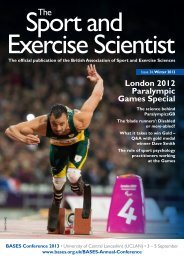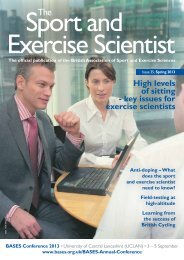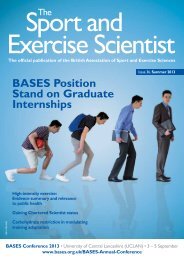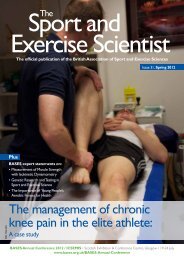Right: Optimising CHO storage is importantin the days prior to competitionCourtesy Anthony HitchingsPizza slices to performance nutritionAnnie Lambeth-Mansell presents a case study of nutrition support for a 24-hour canoe event.IntroductionThis case study documents a nutritionalconsultation and subsequent advice offeredto two amateur (but experienced) malepaddlers prior to the Devizes to WestminsterInternational Canoe Race (April <strong>2012</strong>). In thisevent they raced in the Senior Doubles classand came in the top 20 out of 155 starters.The reasons for seeking nutritional advice weredue to previously experiencing dramatic lossesin physical and mental energy during the race,and having a lack of knowledge on suitable foodchoices. “Nutrition was always a challenge for meright from that first race (1988) and I admit to beingsceptical that there was a good solution, it is an issuefor so many competitors.”Physiological and nutritional demandsThe event the paddlers were working towardscovers 125miles of continuous canoeing (with77 portages), and competitors can take up to24 hours to complete. Aerobic metabolismaccounts for over 95% of the energy productionover distance events, however in races such asthese surges from the river water and change ofspeed during the portages require high intensityefforts. Races like this require great demands onthe competitors’ bodies, and therefore fuellingperformance is extremely important. In manyendurance events there is an energy imbalance,with the body generating greater energyexpenditures than the energy intakes (Enqvist etal., 2010). Kayaking at a rate of 6.5 to 8 km/hourexpends approximately 400 kcal/hour and energyexpenditure over a 24-hour simulated adventurerace has been reported to be 750 ± 100 kcal/hour (Enqvist et al., 2010). The participantswords: Annie Lambeth-MansellAnnie works at the Institute of Sportat the University of Worcester and is aBASES accredited sport and exercisescientist.ReferencesBurke, L.M. & Hawley, J.A.(2002). Fat adaptation strategies forendurance performance. InternationalSports Medicine Journal, 3 (1), 1-5.Enqvist, J.K. et al. (2010).Energy turnover during 24 hours and6 days of adventure racing. Journal ofSports Sciences, 28 (9), 947-955.Noakes, T. (2007). Hydrationin the marathon, using thirst togauge safe fluid replacement. SportsMedicine, 37, 463-466.Yeo, W.K., Carey, A.L., Burke,L., Spriet, L.L. & Hawley, J.A.(2011). Fat adaptation in well-trainedathletes: Effects on cell metabolism.Applied Physiology, Nutrition andMetabolism, 36 (1), 12-22.in the study by Enqvist et al. (2010) reportedfinding it impossible to consume sufficientcalories to maintain energy balance, thusresulting in significantly reduced muscle glycogenconcentrations by the end of the race. The needfor energy intake to minimise energy deficitsis the primary concern during a 24-hour eventand dietary strategies are vital to maintain fluidbalance and carbohydrate (CHO) fuel stores.The body has limited stores of muscle glycogenrelative to the fat stores and during moderate/hard exercise these stores will deplete in 90-120minutes. Therefore optimising CHO storage byconsuming a diet which contains 6-10 g/kg isimportant in the days prior to competition. Thiscan maximally fuel muscles and prevent needlessfatigue, increase muscle glycogen and improveperformance.Shifting to a high fat dietThe advice given to the paddlers 8 weeksprior to the race was to incorporate foodssuch as coconut, olive oil, avocados, olives eggs,oily fish seeds and nuts, while reducing theirintake of high CHO foods, in order to maintainenergy balance. The body uses fat as a fuelvery effectively during exercise and it is easyto increase the fat metabolism potential of themuscles by increasing the amount of fat in thediet. Several studies have looked at fat-adapteddiets to provide greater fat utilisation duringendurance events. Findings reveal that high-fatdays in the weeks prior to CHO loading wereassociated with an increased reliance on fatoxidationafter prolonged exercise and sparing ofmuscle glycogen reserves (Burke & Hawley, 2002;Yeo et al., 2011).10 The Sport and Exercise Scientist n <strong>Issue</strong> <strong>33</strong> n <strong>Autumn</strong> <strong>2012</strong> n www.bases.org.uk
Race day nutritionFuelling up on race day is vital; however consuming foods duringexercise can be difficult, which was a particular concern forthese competitors, “I never found it easy to eat and had to forcefood and drink in after about 8 hours, usually ended up doing last50 miles with no drink or food as I could not physically take it. I havebeen physically sick during the race in the past.” It is important toidentify strategies to overcome this as carbohydrates and fluidmixtures can improve performance and reduce physiologicaldistress on the cardiovascular, central nervous and muscularsystems. Approximately 3-4 hours before competition began,the paddlers were advised to eat a meal containing 140-200g CHO in order to increase muscle glycogen, and then sipon water until the start of the event. In the field of sportsnutrition it is generally recommended that in the 30-60 minutesbefore activity a final high CHO snack is consumed to topupblood glucose. However, during ultra-endurance eventsthese immediate pre-exercise foods are unlikely to have anyperformance effect, and the paddlers were advised only sipwater during this time to ensure endogenous fat was alreadymobilised at the start, and insulin levels were not elevated by animmediate pre-exercise food.As there are only sufficient CHO stores in the body for arelatively short duration, these need to be consumed duringexercise in order for intensity to be maintained. The maximalrate the body can use CHO consumed during exercise isapproximately 60 g/hour (approximately 250 kcal). Withenergy expenditure of 300-750 kcal/hour CHO consumptioncannot provide all of the energy required once these storesare depleted. Competitors need to intake as close as possibleto 60 g/CHO/hour to maximise fuel availability and conservestores, but not exceed this as it will not be absorbed potentiallycausing gastro-intestinal disturbance. In addition, the elevatedinsulin could decrease fat use as a fuel, further depleting thelimited glycogen stores. Previously these competitors had notconsidered a specific nutritional plan and only started eatingafter 3-4 hours, from a choice of jam sandwiches/pizza slices/banana/flapjack/chocolate. Following the consultation theyconsumed 500 ml 8% mix of CHO drink plus an CHO gel everyhour (just over 60 g/CHO/hour) for the duration of the eventwithout any reported problems, plus an occasional piece offlapjack or bite of banana. This supports recommendations thatduring exercise some protein is consumed every 4 hours tohelp prevent the release of cortisol, a stress hormone that canincrease muscle breakdown and decrease fat metabolism.HydrationWhen racing for 24 hours poor hydration could have causedserious health consequences. Current guidelines recommendthat during exercise athletes consume 600-1200 ml/hour offluids containing 4-5% CHO and 0.5-0.7 g/l sodium, howeverwhen frequently consuming snacks there is no need to addextra sodium to drinks. The human body, like every creature onthe planet, is highly attuned to dictating fluid needs by thirst. It isrecommended athletes listen to their body and drink accordingto thirst, “when athletes drink according to thirst, the risk thatthey will over-drink is minimised and there is no evidence thatthey are at any significant disadvantage” (Noakes, 2007).Sports science in practiceFollowing the race the competitors reported: “The nutritionplan worked like a dream, at no time did we feel sick, full, hungry orthirsty and we kept up a good pace, bang on schedule, all the waydown. We remained very positive throughout the entire race, had nocramps or muscle spasms and completed the race 20 minutes insideour predicted time.” When asked what their key “take home”messages were from the experience they responded:• Be open to new ideas and learn from the research• Learn from other peoples’ knowledge and experience• Train and practise your nutrition• Stick to the plan.OverviewEating a balanced diet is the best way to maintain good healthand provide the body with the ideal base for maximumperformance. Consuming sufficient carbohydrates before andduring a race will provide optimum muscle glycogen levels,with carbohydrate snacks and fluids necessary to be consumedthroughout competition. A relatively high-fat diet in the weeksbefore competition will aid fat-oxidation during the event andspare muscle glycogen reserves, which is important during highintensity efforts. A high-carbohydrate and protein meal after arace will replenish stores effectively and aid recovery.Table 1. Summary of guidelines given to paddlers in the current case studyTime PeriodDaily dietTraining dietPre-competition taperRace day: Pre-competitionRace day: During competitionNutritional Guideline• Shift to higher fat diet: replace some carbohydrate food with high healthy-fat foods.• Maintain protein at 1.2-1.4 g/kg/day.• Avoid high carbohydrate foods 3 hours prior to training to promote increased fat metabolismduring exercise.• Experiment with different foods during training to try and find a high carbohydrate/protein foodthat you like and can tolerate.• Immediately after training eat 50 g carbohydrate and 5-10 g protein (tuna sandwich, milkshake,and muesli bar).• Increase carbohydrate intake to 60-70% of daily intake, maintain 20% fat and 15-20% protein.• 3-4 hours before the start consume a high carbohydrate /protein meal containing approximately200 g CHO and 10 g protein. E.g. sandwiches with cheese, fish, meat, peanut butter or egg; cerealwith milk; pasta with a meat/fish/cheese sauce; jacket potato and filling.• All of these could be accompanied by some yogurt and fruit juice to increase the carbohydrateand protein intake. Avoid high fibre and high fat that can cause gastric distress.• 60 g carbohydrate/hour and 5-10 g protein every 4 hours.• Drink fluids to thirst and supplement extra carbohydrate from gels and high carbohydrate snacks.• Avoid high fat foods which will sit in the stomach but some healthy fats can make food morepalatable and increase fat use by the body during exercise.The Sport and Exercise Scientist n <strong>Issue</strong> <strong>33</strong> n <strong>Autumn</strong> <strong>2012</strong> n www.bases.org.uk11


